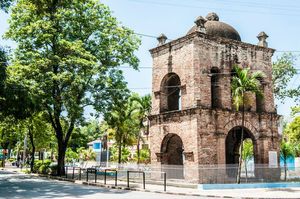

San Juan Evangelista Tower, Bayamo
Visit the fascinating monuments compound of Bayamo and enjoy the urban evolution of the San Juan neighbourhood.
Around the year 1798 the Iglesia de San Juan Evangelista Church was the first one in America in which the deads began to be buried outside the enclosure, specifically opencast. With the fire of 1869 the church was totally scorched just standing the portico with the bell tower which became, from that moment on, in the entrance of the cemetery.
As the years went by and the growth of the San Juan neighbourhood, just as the cemetery, the neighbours began to complain of the bad smell spreading out because of this last one. Due to this, the lawyer Elpidio Estrada decided to give his own lands located on the left shore of the Bayamo River, with the aim of being used again as cemetery.
Shortly after, in 1920, the Bayamo Municipal Government decided to turn the old cemetery in the Plaza de San Juan Square. Since its construction, finished around the 30s, the park was being enlarged and the neighbour evolving with the creation of new streets, such as the Martí Street, and ended up being made up on one side a little triangular park and on the other side the Iglesia de San Juan Church, become by the end of the 50s in a monumental-historic compound made by different parts.
One side is the Plaza de San Juan Square with the obelisk in memory of the poet José Joaquín Palma (1844-1911).
IN the second section with the tiny park which has a commemorative card of the fight between Ñico López and his group in front of a patrol of Batista’s army on the 26th July 1953.
The third one, and of great importance for the people of Bayamo, the tower, which goes back to the 18th century, characterized by the funerary monument hosted on its inside and located above the tomb of the Major General Francisco Vicente Aguilera. This is the tower which worked as porticu of the first opencast cemetery in America.
Furthermore, it should be emphasized the Retable of the Heroes with the statue of Francisco Vicente Aguilera. Monument erected in 1957 with a structure of reinforced concrete recover with black granite and in which there are inscribed 33 medallions of important heroes who fought in the Independence Wars and were designed on both sides of the bronze statue dedicated to the Major General of the Liberator Army Francisco Vicente Aguilera (1821-1877).
Do not miss the chance of admiring one of the most important historical compounds of the city of Bayamo.
More information:
Location:
Intersección de las calles Amado Estévez, José Martí y Capotito, Bayamo. Granma, Cuba.
Interactive map:
Granma
What to see:
- Bayamo
- Céspedes Park
- San Salvador Major Parish Church
- Paseo Bayamés Promenade
- Ventana de Luz Vázquez Window
- Casa de Estrada Palma House
- San Juan Evangelista Tower
- Cupaynicú Botanic Garden
- Dos Ríos
- Sierra Maestra Range Great National Park
- Comandancia General de La Plata High Command
- Santo Domingo
- Manzanillo
- Céspedes Park
- Iglesia de la Purísima Concepción Church
- Manzanillo Theater
- Niquero
- Alegría del Pío
- Desembarco del Granma National Park
- Cabo Cruz
- El Guafe Natural Archaeological Trail
- Pilón
Beaches:
Museums:
Other nearby destinations:
Why "Trip Cuba"?
Trip Cuba is an organization of Cuban agencies whose objectives are:
- ✓ To make Cuba, its culture and its heritage known.
- ✓ To promote sustainable tourism.
- ✓ To support the local economy, prioritizing direct contact with Cuban agencies.
Travel Agencies
If you are a travel agency or tour operator and you are looking forward to any assistance or collaboration to plan trips to Cuba, rely on our extensive experience
Copyright www.TripCuba.Org © - All rights reserved
All our agencies are duly registered in the National Registry of Travel Agencies of the Chamber of Commerce of the Republic of Cuba.







